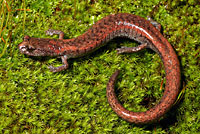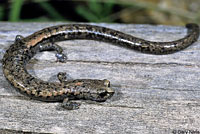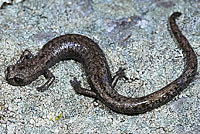|
 |
Adult, Caliente Creek, Kern County
|
 |
 |
 |
| Adult, Caliente Creek, Kern County |
Adult, Caliente Creek, Kern County |
 |
 |
 |
| Adult, Caliente Creek, Kern County |
Adult, Caliente Creek, Kern County |
Adult, Caliente Creek, Kern County |
 |
 |
 |
| Adult, Caliente Creek, Kern County |
Adult, Caliente Creek, Kern County |
 |
 |
 |
| Adult, Caliente Creek, Kern County |
Adult, Caliente Creek, Kern County |
 |
 |
 |
| Adult, Caliente Creek, Kern County |
Adult, Caliente Creek, Kern County |
Underside of adult, Caliente Creek,
Kern County |
 |
 |
 |
| Adult, Fort Tejon area, Tehachapi Mountains, Kern County |
Adult, Fort Tejon area, Tehachapi Mountains, Kern County
|
 |
 |
 |
| Adult, Caliente Creek area, Kern County © Ryan Sikola |
 |
 |
 |
| Adult, Fort Tejon area, Tehachapi Mountains, Kern County © Ryan Sikola |
|
 |
|
| |
Adult, Caliente Creek, Kern County
© Ryan Sikola
|
|
Herpetologist Sam Sweet has made a very interesting well-illustrated public forum post about Tehachapi Slender Salamanders and their habitat, including a shot of the place where the first specimen was found, and a range extension from a considerably dryer habitat than is typically expected for this species. (In 1957, when the salamander was discovered, they actually thought that it was a variation of B. attenuatus !) You can read it and the ensuing discussion here if it's still online.
|
| Juveniles |
 |
 |
|
| Juvenile, Fort Tejon area, Tehachapi Mountains, Kern County © Ryan Sikola |
|
| |
|
|
| Comparison With a Sympatric Slender Salamander Species |
| |
 |
|
| |
Top: B. nigriventris
Bottom: B stebbinsi -
Tehachapi Slender Salamander
These species coexist in a small area in the Ft. Tejon area and the Tehachapi Mountains. These two salamaders were found together under the same rock. The B. stebbinsi here is a bit shorter than the B. nigriventris, but note the much larger legs and toes of B. stebbinsi. |
|
| |
|
|
| Habitat |
 |
 |
 |
Habitat, 2,500 ft., Caliente Creek,
Kern County |
Habitat, 2,500 ft., Caliente Creek,
Kern County |
Habitat, 2,500 ft., Caliente Creek,
Kern County |
 |
 |
 |
Habitat, 3,500 ft elevation, Fort Tejon area, Tehachapi Mountains, Kern County
|
Habitat, Caliente Creek, Kern County |
 |
 |
|
| Habitat, Caliente Creek, Kern County |
Habitat, Caliente Creek, Kern County |
|
| |
|
|
| Short Video |
| |
 |
|
| |
A fallen branch is overturned exposing a Tehachapi Slender Salamander. |
|
|
|
|
| Description |
| |
| Size |
Adults are 2 - 2 2/5 inches long (5.1 - 6.1 cm) from snout to vent, 3.5 - 5 inches (9 - 13 cm) in total length.
|
| Appearance |
A small slim salamander, with 18 - 19 costal grooves.
Short limbs, a narrow head, long slender body, very long tail, and conspicuous costal and caudal grooves give this species the worm-like appearance typical of most Slender Salamanders.
Relatively large and robust when compared with most Slender Salamanders, having a fairly broad head, long legs, broad feet, shorter tail, and toes that appear to be slightly more webbed than with other Batrachoseps species.
There are four toes on the front and hind feet, which is also typical of Slender Salamanders.
(Other California salamanders have five toes on the hind feet.)
|
| Color and Pattern |
Color is reddish or brownish. Light beige, tan, black, patches and blotches may form an indistinct dorsal stripe with uneven edges.
|
| Comparison with Sympatric Slender Salamanders |
Coexists with B. nigriventris at several locations in the Tehachapi Mountains where B. stebbinsi can be distinguished by its more robust body with longer legs, largeer feet, distinct toes, and broader head.
|
| Life History and Behavior |
A member of family Plethodontidae, the Plethodontid or Lungless Salamanders.
Plethodontid salamanders do not breathe through lungs. They conduct respiration through their skin and the tissues lining their mouth. This requires them to live in damp environments on land and to move about on the ground only during times of high humidity. (Plethodontid salamanders native to California do not inhabit streams or bodies of water but they are capable of surviving for a short time if they fall into water.)
Plethodontid salamanders are also distinguished by their naso-labial grooves, which are vertical slits between the nostrils and upper lip that are lined with glands associated with chemoreception.
All Plethodontid Salamanders native to California lay eggs in moist places on land.
The young develop in the egg and hatch directly into a tiny terrestrial salamander with the same body form as an adult.
(They do not hatch in the water and begin their lives as tiny swimming larvae breathing through gills like some other types of salamanders.) |
| Activity |
Little is known about this species.
Most Slender Salamander species are active on rainy or wet nights when temperatures are moderate, fall through spring, retreating underground when the soil dries or when air temperature drops to near freezing.
Most surface activity for this species has been observed from February to March or April.
|
| Defense |
Slender salamanders use several defense tactics, including:
- Coiling and remaining still, relying on cryptic coloring to avoid detection.
- Uncoiling quickly and springing away repeatedly bouncing over the ground, then remaining still again to avoid detection.
- Detaching the tail, which wriggles on the ground to distract a predator from the salamander long enough for it to escape.
(After its tail is detached or severed, the salamander will grow a new tail.) |
| Diet and Feeding |
Eats a variety of small invertebrates.
Feeding behavior is not well known, but other Batrachoseps species are sit-and-wait predators that use a projectile tongue to catch prey. |
| Reproduction |
Little is known about the breeding behavior of this species.
Reproduction is terrestrial.
Breeding and egg-laying probably occurs during the unpredictable rainy period which can occur anywhere from from November to February.
Possibly gravid females have been discovered in mid Februrary and early April.
|
| Eggs |
| All species of Slender Salamanders lay eggs, typically in moist places on land. |
| Young |
Young develop completely in the egg and hatch fully formed.
Juvenile salamanders are rarely found, suggesting that they hatch underground at the end of the wet season and remain underground during the beginning of their lives.
|
| Habitat |
Inhabits north-facing moist canyons and ravines in oak and mixed woodlands in arid to semi-arid locations. Found under rocks, logs, bark, and other debris in moist areas, especially in areas with a lot of leaf-litter, often near talus slopes.
|
| Geographical Range |
Endemic to California.
Found in scattered populations in the Caliente Creek drainage at the juncture of the Sierra Nevada and the Tehachapi Mountains, and in isolated canyons on the northern slopes of the Tehachapi Mountains from Tejon Canyon to Fort Tejon.
One specimen was collected in 1957 near Tehachapi Pass, but none have been found in that area since. |
| Elevational Range |
Occurs at elevations of 2,000 - 4,600 ft. (610 - 1,400 m).
|
| Notes on Taxonomy |
B. stebbinsi as it is currently known might actually consist of two species:
In their species account of B. stebbinsi in Amphibian Declines: The Conservation Status of United States Species, Robert Hansen and David Wake cite unpublished data indicating that "…high levels of genetic differentiation, as well as differences in coloration and size, between the two principal distributional units of B. stebbinsi (Caliente Canyon versus Tehachapi Mountains) strongly suggest that 2 species are represented. (Jockusch, 1996; Jockusch and Wake, 2002; D.B. Wake and colleagues, unpublished data)."
Coexists with B. nigriventris at several locations in the Tehachapi Mountains where it can be distinguished by its long legs, large feet, distinct toes, and broad head.
Here's a Diagram of the Batrachoseps Complex showing the relationships between species.
Names History
Batrachoseps stebbinsi - Tehachapi Slender Salamander (Brame & Murray 1968, Stebbinsi 1985, 2003, 2012)
|
| Conservation Issues (Conservation Status) |
| Listed as a threatened species by the State of California because the limited sites it inhabits makes it extremely vulnerable to any changes in its habitat. Planned developments in the Tehachapi Mountains could disturb habitat and threaten some populations. |
|
| Taxonomy |
| Family |
Plethodontidae |
Lungless Salamanders |
Gray, 1850 |
| Genus |
Batrachoseps |
Slender Salamanders |
Bonaparte, 1841 |
Species
|
stebbinsi |
Tehachapi Slender Salamander |
Brame & Murray, 1968 |
|
Original Description |
Brame and Murray, 1968 - Sci. Bull. Nat. Hist. Mus. Los Angeles Co., No. 4, p. 18
from Original Description Citations for the Reptiles and Amphibians of North America © Ellin Beltz
|
|
Meaning of the Scientific Name |
Batrachoseps: Greek - amphibian, frog lizard - describes lizard-like appearance.
stebbinsi: Honors Robert C. Stebbins.
from Scientific and Common Names of the Reptiles and Amphibians of North America - Explained © Ellin Beltz
|
|
Similar Neighboring Salamanders |
Batrachoseps relictus
Batrachoseps robustus
Batrachoseps simatus
Batrachoseps gregarious
Batrachoseps sp. Fairview/Upper Kern Canyon
Breckenridge Mountain Batrachoseps
|
|
More Information and References |
California Department of Fish and Wildlife
AmphibiaWeb
Hansen, Robert W. and Shedd, Jackson D. California Amphibians and Reptiles. (Princeton Field Guides.) Princeton University Press, 2025.
Stebbins, Robert C., and McGinnis, Samuel M. Field Guide to Amphibians and Reptiles of California: Revised Edition (California Natural History Guides) University of California Press, 2012.
Stebbins, Robert C. California Amphibians and Reptiles. The University of California Press, 1972.
Flaxington, William C. Amphibians and Reptiles of California: Field Observations, Distribution, and Natural History. Fieldnotes Press, Anaheim, California, 2021.
Samuel M. McGinnis and Robert C. Stebbins. Peterson Field Guide to Western Reptiles & Amphibians. 4th Edition. Houghton Mifflin Harcourt Publishing Company, 2018.
Stebbins, Robert C. A Field Guide to Western Reptiles and Amphibians. 3rd Edition. Houghton Mifflin Company, 2003.
Behler, John L., and F. Wayne King. The Audubon Society Field Guide to North American Reptiles and Amphibians. Alfred A. Knopf, 1992.
Powell, Robert., Joseph T. Collins, and Errol D. Hooper Jr. A Key to Amphibians and Reptiles of the Continental United States and Canada. The University Press of Kansas, 1998.American Museum of Natural History - Amphibian Species of the World 6.2
Bartlett, R. D. & Patricia P. Bartlett. Guide and Reference to the Amphibians of Western North America (North of Mexico) and Hawaii. University Press of Florida, 2009.
Bishop, Sherman C. Handbook of Salamanders. Cornell University Press, 1943.
Lannoo, Michael (Editor). Amphibian Declines: The Conservation Status of United States Species. University of California Press, June 2005.
Petranka, James W. Salamanders of the United States and Canada. Smithsonian Institution, 1998.
Thelander, C. G., ed. Life on the Edge: A Guide to California's Endangered Natural Resources Volume I: Wildlife.
Biosystems Books, Santa Cruz, California. 1994.
|
|
|
The following conservation status listings for this animal are taken from the April 2024 State of California Special Animals List and the April 2024 Federally Listed Endangered and Threatened Animals of California list (unless indicated otherwise below.) Both lists are produced by multiple agencies every year, and sometimes more than once per year, so the conservation status listing information found below might not be from the most recent lists. To make sure you are seeing the most recent listings, go to this California Department of Fish and Wildlife web page where you can search for and download both lists:
https://www.wildlife.ca.gov/Data/CNDDB/Plants-and-Animals.
A detailed explanation of the meaning of the status listing symbols can be found at the beginning of the two lists. For quick reference, I have included them on my Special Status Information page.
If no status is listed here, the animal is not included on either list. This most likely indicates that there are no serious conservation concerns for the animal. To find out more about an animal's status you can also go to the NatureServe and IUCN websites to check their rankings.
Check the current California Department of Fish and Wildlife sport fishing regulations to find out if this animal can be legally pursued and handled or collected with possession of a current fishing license. You can also look at the summary of the sport fishing regulations as they apply only to reptiles and amphibians that has been made for this website.
|
| Organization |
Status Listing |
Notes |
| NatureServe Global Ranking |
G2G3 |
Imperiled - Vulnerable |
| NatureServe State Ranking |
S2 |
Imperiled |
| U.S. Endangered Species Act (ESA) |
None |
|
| California Endangered Species Act (CESA) |
ST |
Listed as Threatened 6/27/1971 |
| California Department of Fish and Wildlife |
None |
|
| Bureau of Land Management |
S |
Sensitive |
| USDA Forest Service |
None |
|
| IUCN |
VU |
Vulnerable |
|
|
|








































